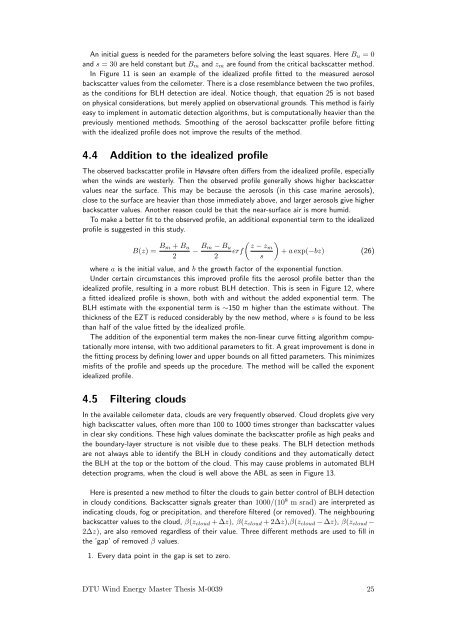Boundary-layer height detection with a ceilometer at a coastal ... - Orbit
Boundary-layer height detection with a ceilometer at a coastal ... - Orbit
Boundary-layer height detection with a ceilometer at a coastal ... - Orbit
Create successful ePaper yourself
Turn your PDF publications into a flip-book with our unique Google optimized e-Paper software.
An initial guess is needed for the parameters before solving the least squares. Here B u = 0<br />
and s = 30 are held constant but B m and z m are found from the critical backsc<strong>at</strong>ter method.<br />
In Figure 11 is seen an example of the idealized profile fitted to the measured aerosol<br />
backsc<strong>at</strong>ter values from the <strong>ceilometer</strong>. There is a close resemblance between the two profiles,<br />
as the conditions for BLH <strong>detection</strong> are ideal. Notice though, th<strong>at</strong> equ<strong>at</strong>ion 25 is not based<br />
on physical consider<strong>at</strong>ions, but merely applied on observ<strong>at</strong>ional grounds. This method is fairly<br />
easy to implement in autom<strong>at</strong>ic <strong>detection</strong> algorithms, but is comput<strong>at</strong>ionally heavier than the<br />
previously mentioned methods. Smoothing of the aerosol backsc<strong>at</strong>ter profile before fitting<br />
<strong>with</strong> the idealized profile does not improve the results of the method.<br />
4.4 Addition to the idealized profile<br />
The observed backsc<strong>at</strong>ter profile in Høvsøre often differs from the idealized profile, especially<br />
when the winds are westerly. Then the observed profile generally shows higher backsc<strong>at</strong>ter<br />
values near the surface. This may be because the aerosols (in this case marine aerosols),<br />
close to the surface are heavier than those immedi<strong>at</strong>ely above, and larger aerosols give higher<br />
backsc<strong>at</strong>ter values. Another reason could be th<strong>at</strong> the near-surface air is more humid.<br />
To make a better fit to the observed profile, an additional exponential term to the idealized<br />
profile is suggested in this study.<br />
B(z) = B m + B u<br />
2<br />
− B m − B u<br />
erf<br />
2<br />
( z − zm<br />
s<br />
)<br />
+ a exp(−bz) (26)<br />
where a is the initial value, and b the growth factor of the exponential function.<br />
Under certain circumstances this improved profile fits the aerosol profile better than the<br />
idealized profile, resulting in a more robust BLH <strong>detection</strong>. This is seen in Figure 12, where<br />
a fitted idealized profile is shown, both <strong>with</strong> and <strong>with</strong>out the added exponential term. The<br />
BLH estim<strong>at</strong>e <strong>with</strong> the exponential term is ∼150 m higher than the estim<strong>at</strong>e <strong>with</strong>out. The<br />
thickness of the EZT is reduced considerably by the new method, where s is found to be less<br />
than half of the value fitted by the idealized profile.<br />
The addition of the exponential term makes the non-linear curve fitting algorithm comput<strong>at</strong>ionally<br />
more intense, <strong>with</strong> two additional parameters to fit. A gre<strong>at</strong> improvement is done in<br />
the fitting process by defining lower and upper bounds on all fitted parameters. This minimizes<br />
misfits of the profile and speeds up the procedure. The method will be called the exponent<br />
idealized profile.<br />
4.5 Filtering clouds<br />
In the available <strong>ceilometer</strong> d<strong>at</strong>a, clouds are very frequently observed. Cloud droplets give very<br />
high backsc<strong>at</strong>ter values, often more than 100 to 1000 times stronger than backsc<strong>at</strong>ter values<br />
in clear sky conditions. These high values domin<strong>at</strong>e the backsc<strong>at</strong>ter profile as high peaks and<br />
the boundary-<strong>layer</strong> structure is not visible due to these peaks. The BLH <strong>detection</strong> methods<br />
are not always able to identify the BLH in cloudy conditions and they autom<strong>at</strong>ically detect<br />
the BLH <strong>at</strong> the top or the bottom of the cloud. This may cause problems in autom<strong>at</strong>ed BLH<br />
<strong>detection</strong> programs, when the cloud is well above the ABL as seen in Figure 13.<br />
Here is presented a new method to filter the clouds to gain better control of BLH <strong>detection</strong><br />
in cloudy conditions. Backsc<strong>at</strong>ter signals gre<strong>at</strong>er than 1000/(10 8 m srad) are interpreted as<br />
indic<strong>at</strong>ing clouds, fog or precipit<strong>at</strong>ion, and therefore filtered (or removed). The neighbouring<br />
backsc<strong>at</strong>ter values to the cloud, β(z cloud + ∆z), β(z cloud + 2∆z),β(z cloud − ∆z), β(z cloud −<br />
2∆z), are also removed regardless of their value. Three different methods are used to fill in<br />
the ’gap’ of removed β values.<br />
1. Every d<strong>at</strong>a point in the gap is set to zero.<br />
DTU Wind Energy Master Thesis M-0039 25
















